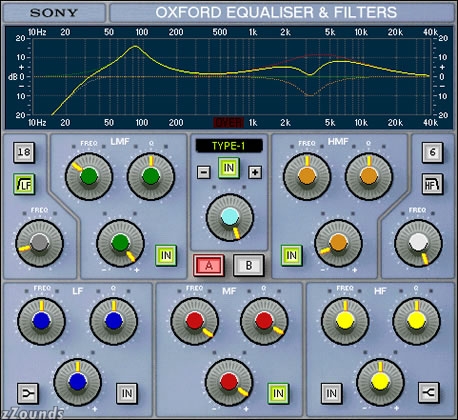Did Tubbys use a parametric EQ?
Moderator: interruptor
Did Tubbys use a parametric EQ?
i wonder if you could tell me if tubbys used a parametric eq when mixing to get that hollow sound and what parametric i can get to get the same effect.
- interruptor
- Posts: 1211
- Joined: Sun Sep 04, 2005 11:46 pm
- Location: Switzerland
- Contact:
Did Tubbys use a parametric EQ?
could you explain in more detail what you mean by hollow sound? are you talking about a static effect or some sort of filter modulation? is the effect applied to the whole mix or just to certain instruments?
Did Tubbys use a parametric EQ?
I'm SURE that Tubby used Param EQ. <BR> <BR>You can watch it on the graphical equalizer of your stereo we you ear a tracks (i can't remember which). You see the move that tubby do on the param eq on the screen of the stereo. <BR> <BR>Beceaus you see the boosted frequance flying from left to right. <BR> <BR>Jah Bless DUBWISE! ALMIGHTY DUBWISE! <BR> <BR>KoCha www.almighty-dub.com
KoCha, reggae-dub producer
Almighty Dub Records - Independent Reggae Dub Production
Open Dub Foundation - The WorldWide Dub Meeting
Almighty Dub Records - Independent Reggae Dub Production
Open Dub Foundation - The WorldWide Dub Meeting
I would say the standard sort of eq in plug in form is parametric (and I would think all serious mixing desks have parametric eq, and all the classic outboard eq I have seen emulated is parametric)).Klaus5 wrote:What exactly is a parametric EQ and how is it used? How is it different to a "standard" EQ which just has sliders for certain frequencies?
Parametric means the bandwith (the range of frequency being affected (the width of your hump or dip) - often called 'q'), the centrepoint frequency of that band (for Tubby effect you need a narrow band and then you then sweep the frequency control up and down) and boost/cut can all be controlled.
(the eq in the picture below also has high and low pass filters and a shelving option on the high and low eq sections)

Basic 'tone' controls have a fixed bandwith and centre frequency and you just get to cut or boost.
Graphic eqs are so called (I think) because the position of the sliders form a visual representation of the frequency curve you have set - a graphic eq splits the signal into a number of fixed frequency bands each of which has a slider to cut or boost each band.

The swept frequency is one of the signature sounds of a Tubby mix (I don't know if he had fully parametric eq or whether it was on his desk or an outboard unit).
Last edited by Neil C on Tue Dec 30, 2008 12:49 am, edited 1 time in total.
Actually no. In the case of a semi-parametric EQ that would be an accurate summary. But as this thread was originally querying that King Tubby EQ sweep effect (so I understood) there is a very critical third control which is only found on fully parametric EQ and this would be the 'Q' or bandwidth control. Altering this will drastically change the shape of the EQ curve.Klaus5 wrote:...So a parametric EQ you set the shape of the curve, then that can be moved up and down (left/right) the frequencies but the overall shape remains intact?
In order to achieve the most effective filter 'swoosh' sound you need to reduce the 'Q' to near it's narrowest setting (fully clockwise or fully anti-clockwise depending on EQ model) then crank up the boost to at least +12dB (careful with those digital levels!) before then sweeping the frequency control smoothly up and down - mids to hi-mids 700Hz-4Khz is the best range to sweep - for that King Tubby like effect. Try routing your hi-hat, snare and cymbals solely to a group and then apply your EQ sweep to that! Better still, route your snare spring reverb to the same group and you will be King Tubby!
I was presuming Klaus understood when I said:noiseboy wrote:Actually no. In the case of a semi-parametric EQ that would be an accurate summary. !Klaus5 wrote:...So a parametric EQ you set the shape of the curve, then that can be moved up and down (left/right) the frequencies but the overall shape remains intact?
'Parametric means the bandwith (the range of frequency being affected (the width of your hump or dip) - often called 'q'), the centrepoint frequency of that band (for Tubby effect you need a narrow band and then you then sweep the frequency control up and down) and boost/cut can all be controlled.'
and when he said shape he meant the resulting shape you would be left with after making the required settings being swept up and down.
Did Tubbys use a parametric EQ?
Hi Neil. I think Klaus understood OK too. I was just picking him up on his conclusion that the overall shape remains intact. Because obviously the shape of the EQ curve can be completely different through the extremities of a bandwidth control. And I have had people ask me in the past how the EQ 'swoosh' effect is achieved and a tight bandwidth appears pretty critical to the process in my experience and as you stated in your previous post so I just thought I'd chip in with my 2 cents.

Did Tubbys use a parametric EQ?
Might be worth mentioning that you can get a just as interesting but quite different sounding sweep effect by cutting the EQ gain control by 12-18 dB instead of boosting it. You'll need to compensate for overall channel level change too regardless of whether you boost or cut otherwise your mix'll go west.